Please use the following link to download the September 2, 2023 issue of the syəcəb
Category: Tulalip News
Coast Salish swag takes over T-Mobile Park

By Micheal Rios, Tulalip News
It’s impossible to know how many Native Americans attended the Seattle Mariners vs. Oakland Athletics baseball game on August 28. But what we do know is the official attendance for the Monday night game, dubbed ‘Salute to Native American Heritage’ night, was announced as a whopping 37,434 people.
And a nice chunk of that thirty-seven grand were citizens of Pacific Northwest tribes who journeyed to the Emerald City hours before first-pitch to get their hands on a highly coveted, limited-edition jersey created by Muckleshoot tribal artists. It was impossible to miss the intricately detailed beaded medallions, always striking cedar woven hats, and various forms of turquoise jewelry that visually proclaimed, “Our culture is alive and thriving!”
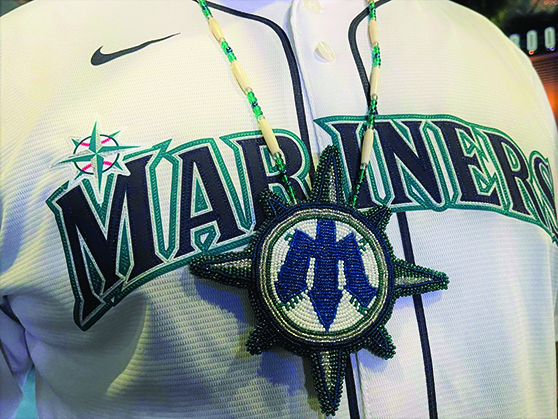
Lines wrapped around the multiple stadium entrances with anxious fans who wanted to be wrapped in a navy blue and Northwest green colored Mariners jersey that featured Coast Salish form line. Only the first 10,000 fans received the first-of-its-kind jersey.
Prior to first pitch, the Muckleshoot Canoe Family took to the always stunningly manicured green grass of T-Mobile Park and shared their culture through dance and song accompanied by traditional hand drum beats.
Throughout the evening, the Mariner’s 11,000-square-foot scoreboard routinely displayed facts about Indigenous tribes of Washington. One example read: “There are more than 30 tribes throughout the state of Washington and over 140,000 Native American citizens in the state alone.” Another read: “Chief Sealth or Chief Seattle was a Suquamish and Duwamish chief respected for his peaceful ways and is the namesake of the city.”
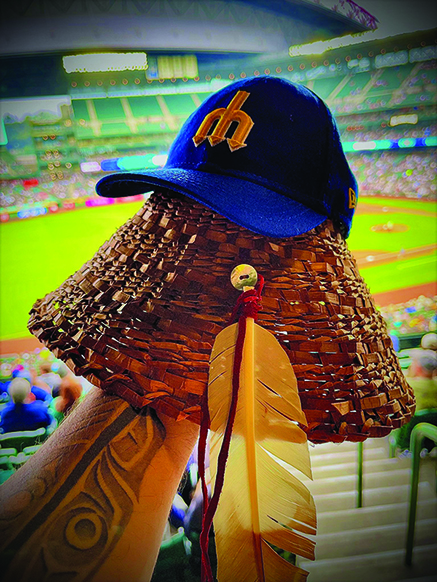
During actual gameplay, the Mariners, who recently took 1st place in their division for the first time in 20 years, gave their adoring fans much to cheer over 9 full innings. Center fielder J.P Crawford hit a 394-foot homerun in the Mariners’ first at-bat of the opening inning. The home team jumped out to a 1-0 lead and never looked back.
Franchise phenom Julio Rodriguez added to the excitement by crushing a two-run, 420-foot bomb in the 4th inning. He finished the game 4-5 with 3 runs scored and 3 RBI. During a postgame interview, Julio said, “It’s really good. I feel like everybody is playing like we all know we could,” Rodríguez said. “It’s been really good seeing everybody having fun, seeing everybody getting good at-bats and getting on base and passing the baton, and getting the big hits when we need them.”
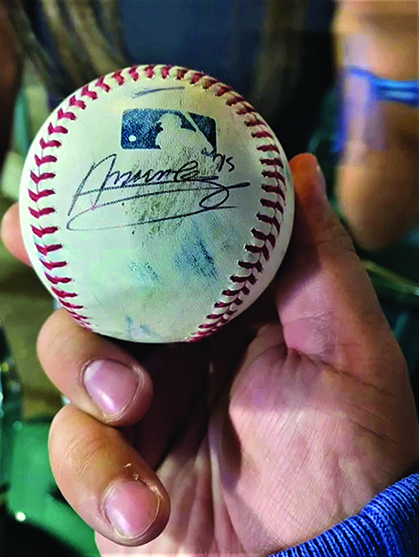
Ultimately, the M’s won a memory-filled, 7-0 shutout in front of the largest Monday crowd they’ve had all season. Adding to the legendary game that was, ‘Salute to Native American Heritage’ night.
Ending Summer in Wild Style
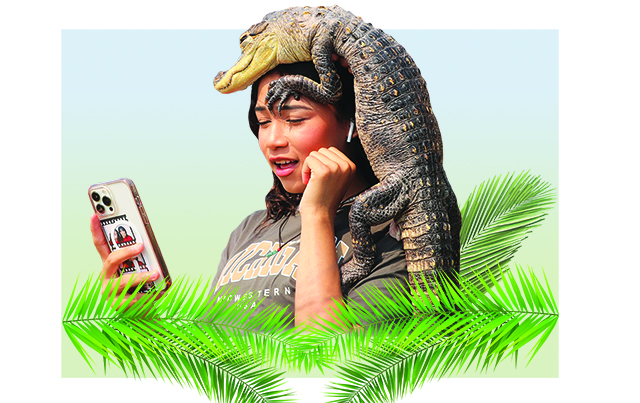
By Micheal Rios, Tulalip News
Summer break came to a screeching halt for many local students who returned to the classroom for the 2023-2024 school year. Fortunately, those who participated in the Tulalip Tribes annual Back 2 School Bash had one final opportunity to let loose with their friends and make some wild memories.
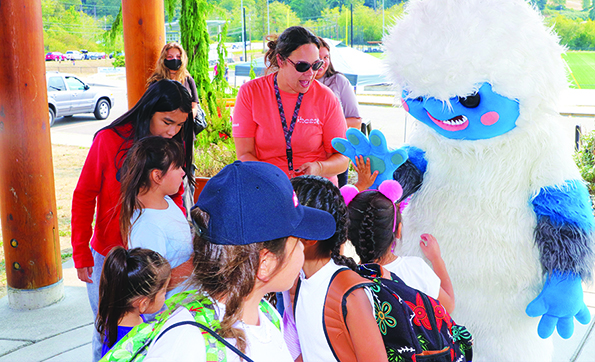
An energetic horde of eager to have fun youth descended on the youth center campus from 12:00pm – 5:00pm on August 23. While their parents and caretakers toured the many resource tables within the gymnasium to learn about services and programs intended to help their students succeed academically, outside the kids ran loose on the asphalt as they dashed from one activity to another.
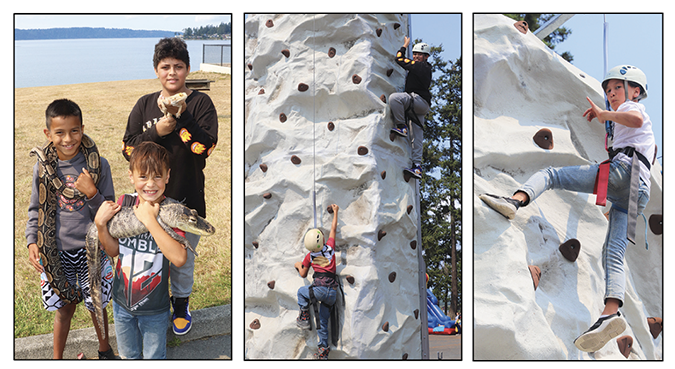
Rock climbing, inflatable slides, an obstacle course, face painting, carnival rides, and games galore made the bash live up to its name. However, some very exotic visitors chauffeured in by a reptile man stole the show for those desiring a true, memorable tale to tell their new classmates.
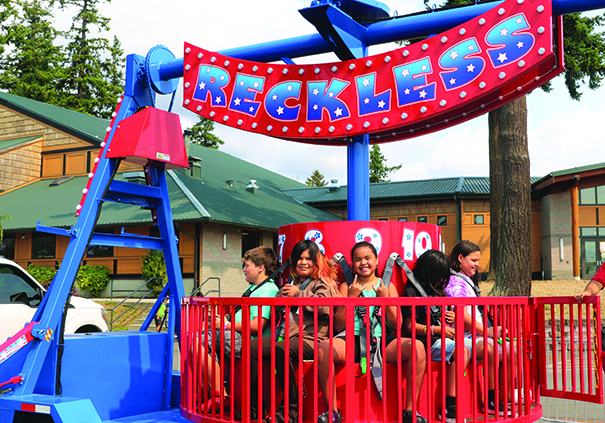
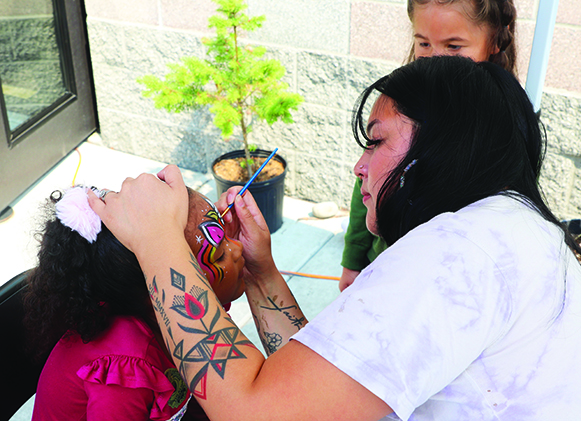
Overlooking Tulalip Bay, a large line of students from all grade levels formed to either hold a bearded dragon iguana, wear a four-foot-long boa constrictor as a scarf, pet a tortoise, or even hold a baby crocodile. The people-friendly reptiles made for quite the scene, and will no doubt make for unbelievable stories told by the youngsters who fire a quick response to an unwitting classmate asking, “Do anything fun this summer?”
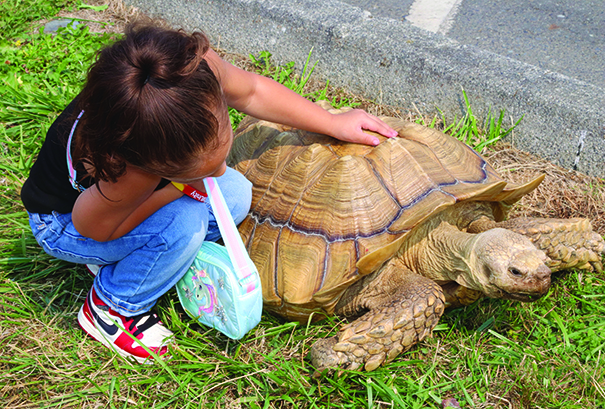
Annual Salmon Bake raises $51,000 to benefit Hibulb Cultural Center
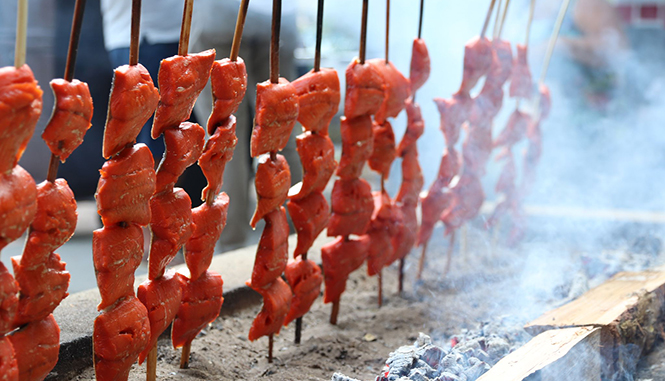
By Kalvin Valdillez, Tulalip News
Kaya, an elder Salish woman with a basket full of clams, has welcomed thousands of people to the Hibulb Cultural Center since the museum first opened its doors in 2011. As a twelve-foot cedar carving known as a welcome pole, Kaya serves as each visitor’s first introduction to a beautiful experience of Tulalip’s culture, history, traditions, and artwork.
Since its establishment, the cultural center has imparted a vast amount knowledge about the Tribe’s ancestral traditions and teachings to the wider community. While providing their guests with interactive exhibits, the museum shares the Tulalip way of life, from present day all the way back to pre-colonial times, through an astounding display of visuals including artwork, photos, documents, and artifacts.
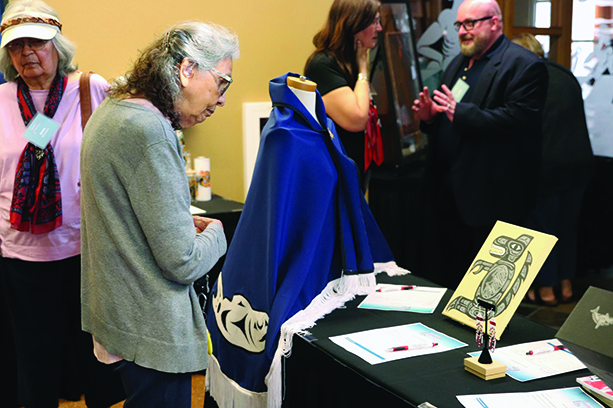
In addition to their exhibits, there is a gathering space that resembles a cedar longhouse, as well as a wall dedicated to all of the Tribe’s military veterans. The cultural center also has three dedicated classrooms where cultural workshops take place throughout each month. And they have an impressive gift shop that often features the works of Tribal artists.
“Over the past 13 years, we have welcomed more than 120,000 guests; 150,000 if you were to include special events,” said Hibulb Cultural Center Manager, Mytyl Hernandez. “That’s 120,000 opportunities to educate people on our culture, our true history, and how much Tulalip does for our outside community. We have had more than 1,500 events here, that includes workshops, lectures, films, private events. 1,500 opportunities for us to invite in our own community and outside communities to learn a little bit more about our culture, our history and about us.”
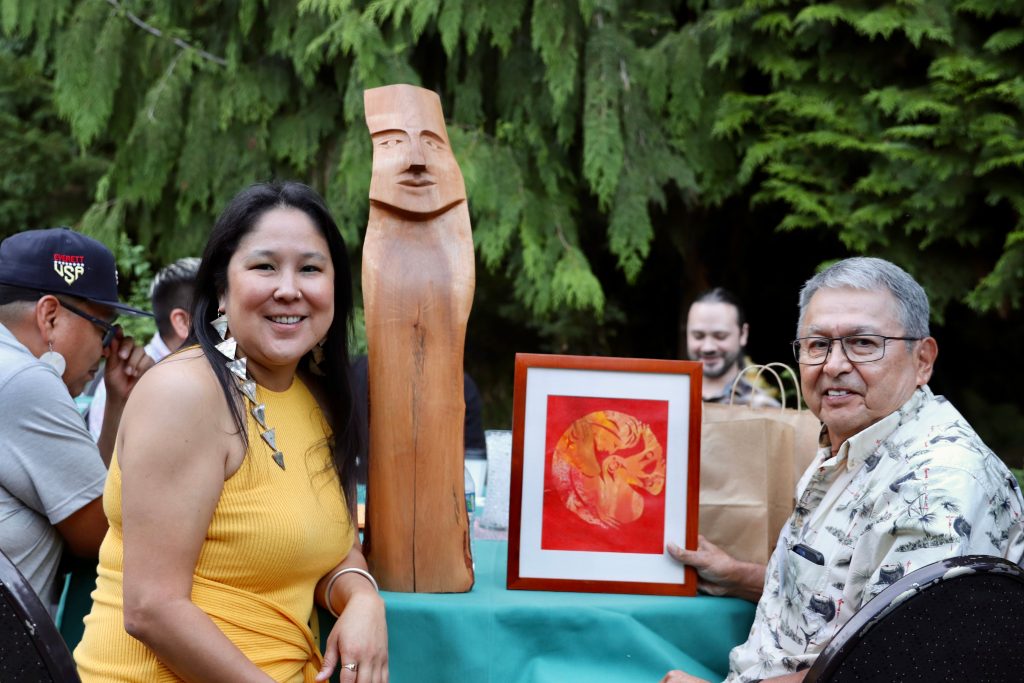
Now an award winning museum, and a top field trip destination for nearby schools, the Hibulb Cultural Center has provided insight and a tribal perspective on issues such as colonialism and assimilation while taking time to celebrate the teachings, values, beliefs, stories, and lifeways of the Tulalip people.
Because the cultural center has grown in popularity and offers new exhibits and workshops on a regular basis, the Tulalip Foundation organized a silent auction and salmon bake to raise funds for the museum’s exhibits, events, and workshops back in 2017.
The Tulalip Foundation is a non-profit organization that supports tribal programs and projects based on five support areas – culture and natural resources, education and workforce, law and justice, community and development, and health and social. The Foundation has made a positive impact on the tribal community and has become well-known throughout the region. Many local companies and nationwide corporations have donated thousands of dollars for the betterment of both Tulalip’s governmental programs as well as community-led and focused projects.
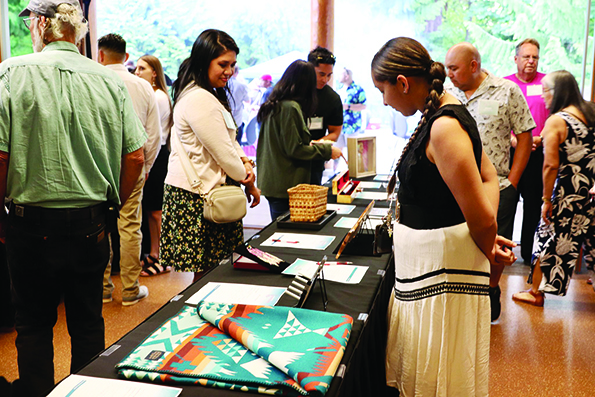
The inaugural salmon bake brought in approximately $25,000 from the silent auction and a number of sponsors. Since then, the Salmon Bake has continued to grow and has become an event that many look forward to each summer. Funds from previous Salmon Bake benefits went toward fan favorite exhibits such as Interwoven History: Coast Salish Wool, Vibrant Beauty: Colors of our Collection, and The Power of Words: A History of Tulalip Literacy, as well as a number of events and workshops including the museum’s annual film festival. Although it’s been seven years since the first event, the Foundation hosted its 5th Annual Salmon Bake this year, after two events were canceled due to the pandemic.
“For all your loving energy and support for the Tulalip community, we raise our hands to you,” said Tulalip Foundation board member Rochelle Lubbers at this year’s salmon bake. “We’re able to celebrate and share our living culture throughout all of our business days. We are not a people of the past. We are here, we are present, and we are thriving.”
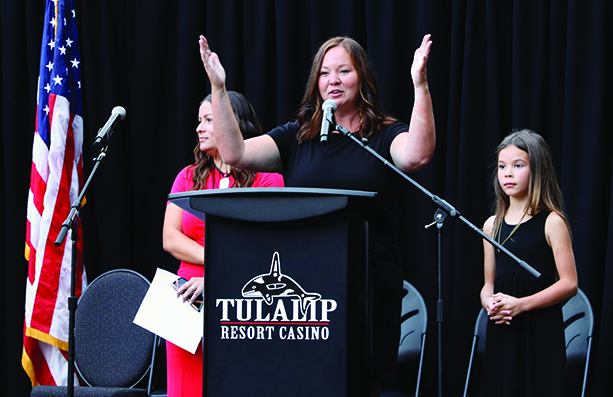
The 2023 Salmon Bake Fundraiser happened on the evening of August 19, and over a hundred of people were in attendance and dressed to the nines. The event was held outdoors, behind the cultural center’s classrooms, where tables with formal settings and a stage were set. About halfway between the stage and the last line of dinner tables, three tribal members were busy behind a smoke screen of traditional deliciousness as the smell of cooking salmon emanated from a rectangle fire pit. As always, the salmon was prepared in real time for all to see by Lance and Tammy Taylor and their grandson Jared, who demonstrated not only the art of a traditional salmon bake, but also the act of passing down ancestral teachings to the next generation.
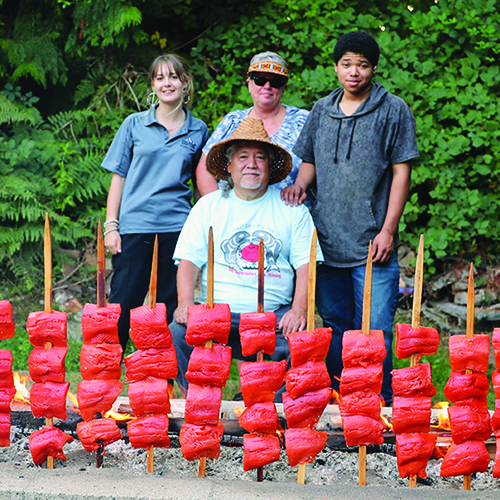
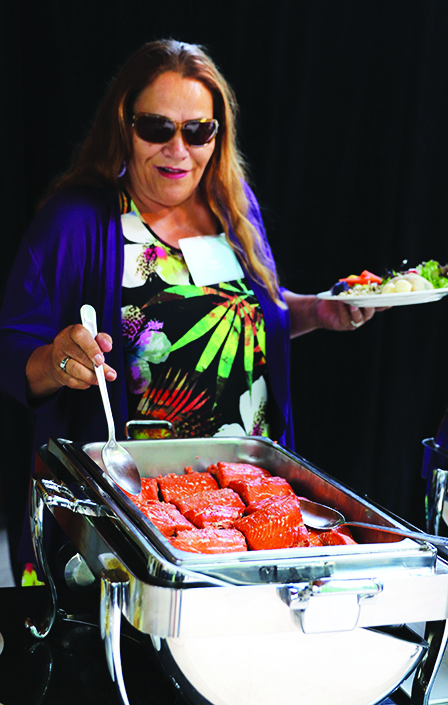
Showcased in the middle classroom of the museum, were rows of artwork donated by over 20 Tulalip artists. Next to each donation was a sheet of paper which detailed information about the art pieces and their creators. At the bottom of each paper were several blank lines where the attendees could place their bids. Included in the vast array of traditional artwork were weavings, paintings, carvings, beadwork, paddles, ribbon skirts, a hand drum, and a flute.
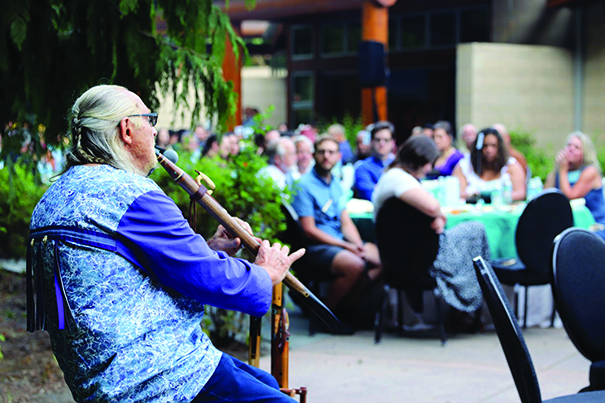
Once the silent auction placed a last call for bids, the guests took their seats at their respective tables. The event began with an opening prayer and the presentation of colors by the Tulalip Honor Guard. Attendees were entranced when Flutist Paul Nyenhuis played a welcome song to kick off the entertainment for the evening. While the sponsors and silent auction bidders enjoyed their fresh king salmon dinners, the youth of the Red Eagle Soaring collective performed a read-through of a play written by one of their young and talented members. It was an emotional and relatable story of aging told from both the youth and elder standpoints of the same few characters.
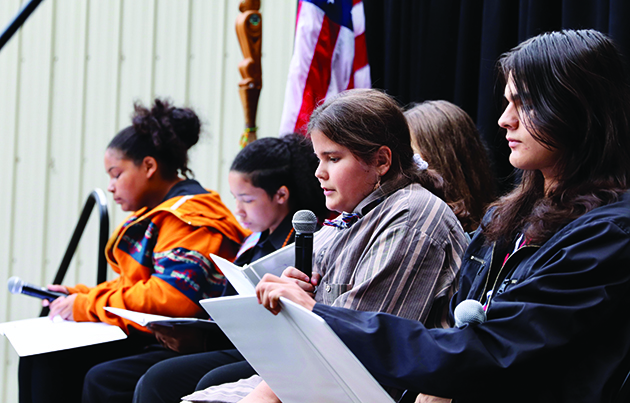
To close out the salmon bake, Mytyl thanked all of the sponsors. And with the help of her teenage daughters, who were babies when the museum first opened, she blanketed each sponsor in attendance. The blankets featured orcas pulling cedar canoes through the Salish Sea and were designed by Tulalip artist James Madison for the summertime tribal canoe journey.
“Thank you for supporting the Hibulb Cultural Center,” Mytyl expressed. “We always have an ask to keep funding our programs, curriculum, efforts, workshops, events, and our new exhibit that will open at the end of October. Our goal for the exhibit, just like it is throughout our museum and in everything that we do, is to make culture accessible to our community.”
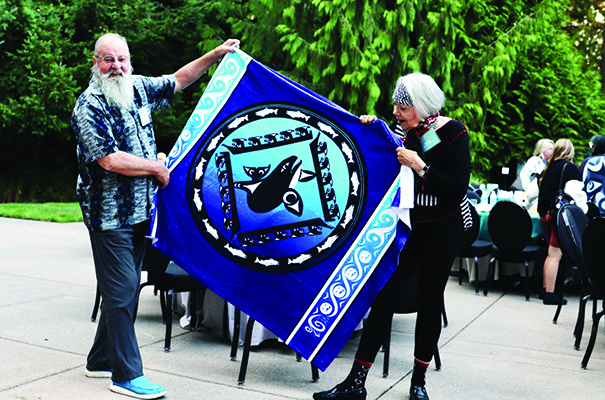
Executive Director of the Tulalip Foundation, Nicole Sieminski, officially announced that a grand total of $51,000 was raised at this year’s silent auction and salmon bake. That is double the amount raised at the inaugural event, which speaks volumes to how the cultural center has grown over the years and its significance to the community.
The following statement was included in this year’s program, “The Tulalip Foundation is proud to host this event for the benefit of the Hibulb Cultural Center as it continues to revive, restore, protect, interpret, collect, and enhance the history, traditional cultural values, and spiritual beliefs of the Tulalip Tribes.”
The Hibulb Cultural Center is currently gearing up to launch a new exhibit that focuses on the traditional languages of the Coast Salish people. The exhibit is slated to open on October 28, so be sure to follow their Facebook page for any updates, as well as details for upcoming events.
August 26, 2023 syəcəb
Please use the following link to download the August 26, 2023 issue of the syəcəb
She Got Game: Empowering Native youth to Rise Above
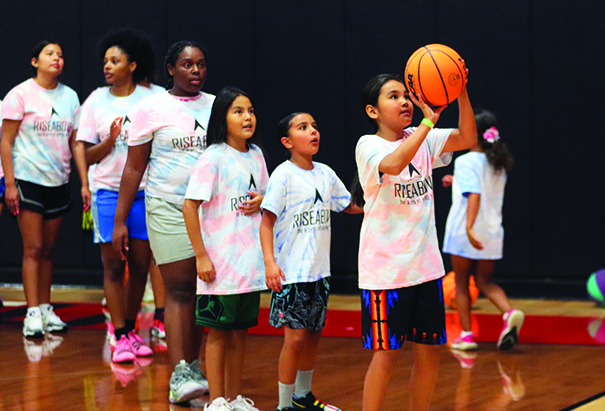
By Micheal Rios, Tulalip News
A Native American hoops legend, Rise Above founder Jaci McCormack (Nez Perce) has lived a fascinating life. So much so that a feature-length film is currently underway that will bring her story of triumph over adversity to the big screen. Executive producers include NBA Hall of Famers Gary Payton and Lenny Wilkens, Hollywood icon Danny Glover, and civil rights activist Gus Newport.
While some may recognize her from her previous work as a victims services coordinator in Tulalip’s Prosecutor’s Office, most know her from her bucket-getting prowess on the hardwood. Whether it was taking down championships in the always competitive Native tournament circuit, or being named an Idaho State player of the year, or her 2005 game-winning jump shot that propelled Illinois State University to a Missouri Valley Conference championship and resulting NCAA tournament appearance.
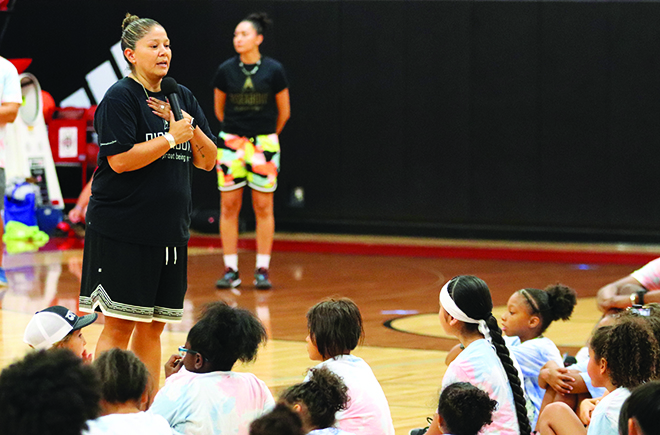
“My story demonstrates that while it isn’t easy to break barriers, it is possible. Representation matters when it comes to Native youth because my story is their story,” Jaci said in an interview with Deadline. “I feel extremely grateful to have found filmmakers and producers that I can trust to tell this story. [They] understand the importance of Indigenous representation in film, and wholeheartedly believe in the social movement this project will support.”
Best known for her role as an executive story editor on the award-winning tv series Reservation Dogs, writer Erica Tremblay (Seneca Nation) has teamed up with Jaci to tell her real-life story of overcoming and rising above the odds in movie form.
“Jaci’s story is an incredible example of Native empowerment, and I was drawn to her personal journey,” said Erica in the same Deadline interview. “There is a real lack of Indigenous representation in film and television and Jaci’s story is exactly what is needed. We need to see members of our communities achieve greatness.”
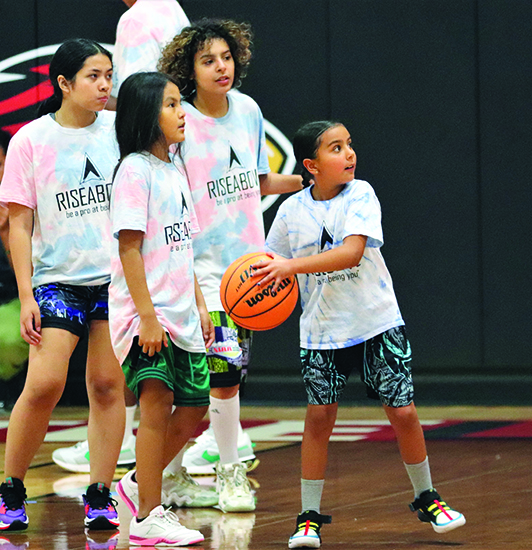
While the film is currently in development, Jaci continues to instill in the next generation of Native youth the many benefits of both striving for and embracing greatness through her nonprofit, aptly named Rise Above. Through this authentically Native-led organization, young Native boys and girls are empowered to lead healthy lives despite the challenges.
Rise Above is capable of delivering education, prevention skills, and mentorship through culturally sensitive programs tailored to their needs. It’s also capable of delivering memory-making moments through basketball clinics that have become legendary for having clinic coaches and fitness experts who themselves are Native Americans that the kids can point to as shining examples of their dreams manifest.
Such was the case on Saturday, August 19, when an estimated 200 youth from across the Pacific Northwest journeyed to Rise Above’s sports fest 2023 hosted at Seattle University’s Redhawk Center. The list of clinic coaches included Freddy Brown III (Makah), who played collegiate basketball for the University of Montana, and Analyss Benally (Navajo), who played collegiately at San Jose State University and professionally in Europe.
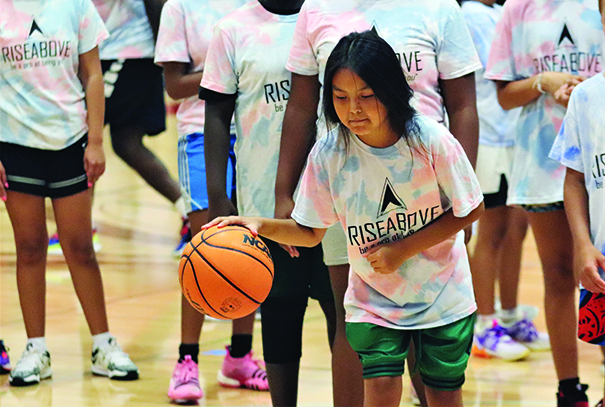
Among the basketball camp participants were several young Tulalip ladies with hoop dreams, such as Charlie Contraro, Shawna Cortez, and twin sisters Cali and Chloe Iukes. Together they represented a Tulalip wave amongst a sea of aspiring ballers intent on sharpening their handles, perfecting their jump shot, and improving their defensive skills to become two-way players effective on both ends of the court.
“Basketball means everything to me,” said Shawna. “I love it so much. Making new friends is one of my favorite parts, and so is having fun during training drills. For me, I’m really small, so I can steal the ball easier when players are dribbling around me; that makes me a good defender. Some players like making passes, others like scoring, I like being a defender because I’m really good at it.”
“My siblings love sports so much. We go to the Marysville YMCA every day, whether to practice to get better or just for the fun of shooting hoops,” added Chloe and Cali’s big sister, Faith. “I hope in time they’ll understand how meaningful this Rise Above camp was, especially with how much work went on behind the scenes from Jaci and her team to make this all possible. But as far as basketball goes, I think my sisters can accomplish anything they set their minds to, as long they continue to put the work in and stay focused on their goals.”
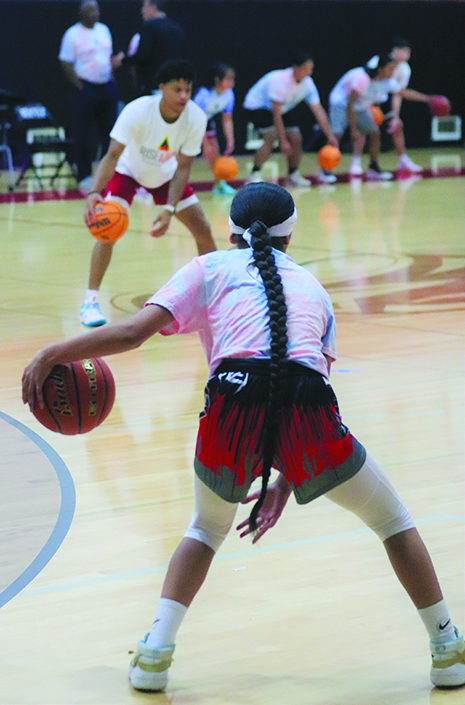
Traditionally seen as a male-dominated sport, basketball is undergoing a transformation as more and more woman-led sports camps rise to prominence. With current and former women collegiate athletes or actual pros at the helm, camps like Rise Above sports fest are rewriting the narrative and proving that the court knows no gender bounds. Native American girls who once felt sidelined are reclaiming their voices and their game, thanks to the guidance of empowered women like Jaci McCormack who walked the same path.
The impact of these camps extends far beyond the bold lines containing 94 ft. by 50 ft. basketball courts. They are nurturing the growth of a new generation of confident young women who carry the lessons they learn into every aspect of life. The skills taught, from teamwork and communication to resilience and time management, equip these girls to thrive both in sports and in their future endeavors.
“This is my second time participating in a Rise Above basketball clinic, and I absolutely love how they operate, especially being so intentional about including us Native youth,” shared JoAnne Sayers (Nez Perce, Tlingit). “It’s so much more than just basketball. They teach us about the power of community, teamwork, and making connections that we can take from here to hopefully add to our support systems when times get tough.
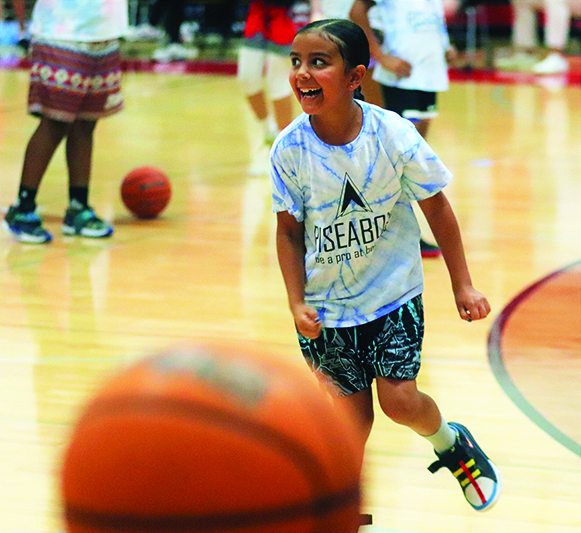
“Living in Seattle, I’m far away from my home reservation, and so organizations like [Rise Above] do a lot for us urban Native kids to bring us together and establish, like, our own tribe through basketball and other sports,” she continued. “Basketball gives us an outlet to maintain good mental health. If you had a bad day, you can find a basketball hoop almost anywhere to go shoot some hoops at and help yourself feel better. And if you had a good day, there’s nothing better than making some buckets and working on your handles. We don’t need alcohol and drugs to relieve stress or anxiety when we’re capable of cleansing our bodies of those things through workouts on the court or in the gym.”
Organizations like Rise Above, and social leaders for change like Jaci, are intent on shattering stereotypes and paving the way for future generations. When young girls witness women excelling as players or leaders, it challenges the long-standing notion that basketball is a man’s world. For example, the weekend’s sports fest was not only simply about teaching basketball skills, but about presenting powerful role models who inspire girls to dream bigger and aim higher.
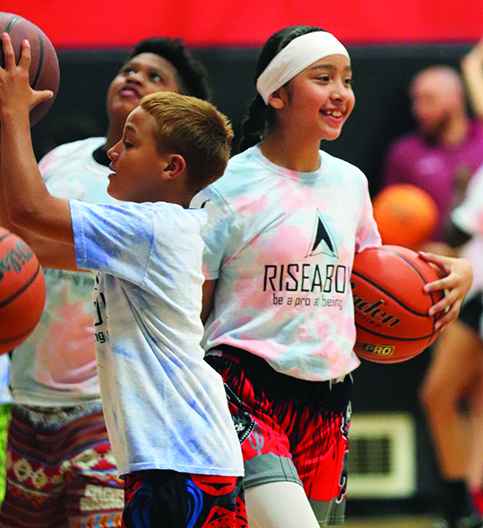
“For us, its all about the kids. When we can expose our kids to more opportunities, and get them in the same room with folks like a Lenny Wilkens, a George Karl, or a Vin Baker who can share their stories and let the kids know it’s possible to rise above childhood challenges and accomplish their dreams, that’s when amazing things truly happen,” said the Rise Above icon Jaci. “You never know what part of a speech, or a moment of candid care during a sports camp, or witnessing a peer get so excited after learning something new might plant a seed and grow into a lifelong lesson that helps someone down the road to rise above. At the end of the day, I just think the more stories of struggles overcome and challenges conquered heard by our kids by those they look up to strengthen our kids to become more successful in their own lives.
“I feel so blessed to be in the position to show our kids, especially the young girls, that I used to be just like them. I’m just an ordinary rez kid with extraordinary dreams who didn’t give up when times got tough,” added Jaci. “Now, to have lived by hoop dreams and to be able to give back to our communities and see these young girls come to our camps and thrive, it’s incredibly touching. My dream is for them to see what I’m doing for them through support for our people and passion for the game, and that they not only rise above to accomplish their dreams, but they also give back to the generation that follows them. That’s how we break the cycles and rewrite the negative narratives of our people, by supporting each other with a shared vision.”
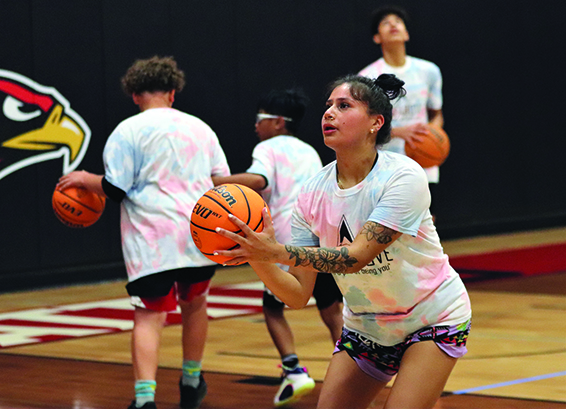
Rise Above will continue illuminating a new horizon for youth on reservations or within urban communities, like Seattle, who dare to dream of sports greatness. Tulalip lady hoopers like Charlie and Shawna, or sisters Chloe and Cali, are not just learning how to shoot hoops; they are learning how to shoot for the stars. With each dribble, pass, and made basket, these girls are discovering their strength, their voice, and their power to shape the game and their world, on their own terms.
Elders Potlatch: A Celebration of Smiles and Joy
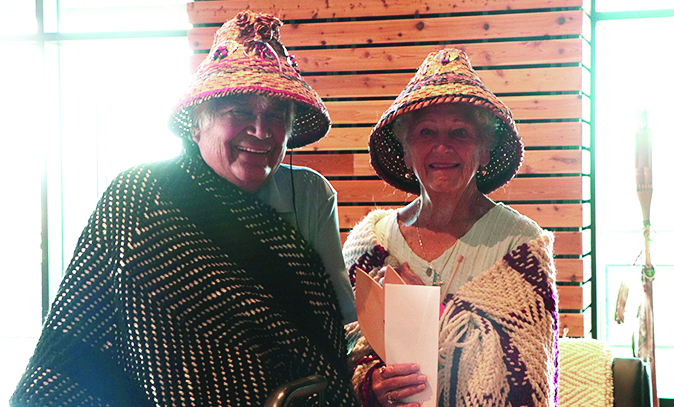
By Wade Sheldon, Tulalip News
Suns out, elders out, as the 2023 Tulalip Elder Potlatch was underway on August 17 inside the Tulalip Gathering Hall. Over a thousand elders were in attendance – some from as far north as Canada and as far south as New Mexico – all looking forward to intermingling with their compatriots, friends, and family, which they usually don’t get to see.
Buses and caravans arrived throughout the morning, and attendees could shop outside from local vendors or enjoy the breakfast being served inside. At 11:00 a.m., the Tulalip Veterans carried the flags inside signaling the beginning on the ceremony. A welcome song by Tulalip tribal member Ray Fryberg and family was sung before acknowledging the oldest elders in attendance.
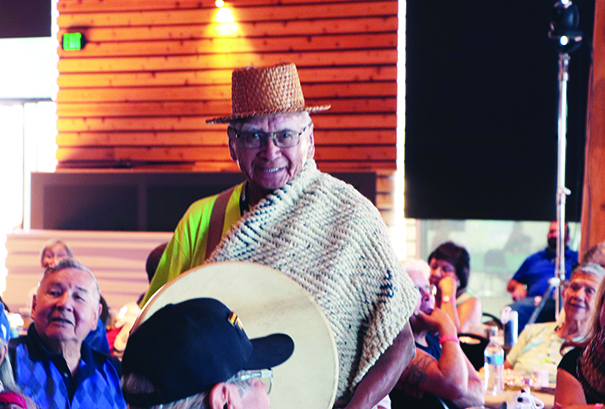
Dale Jones, Tulalip tribal member, announced Don Smith of Cheyanne as the oldest person in attendance at 95 years old. Then he also acknowledged the most senior Tulalip tribal members, Joan Jones, 90, and Hank Williams, 93. All were blessed with a handmade cedar hat, blanket, and drum.
After the songs were sung, speeches made, and the gifts handed out, lunch was served. On the menu was a feast of clams, crab, salmon, and much more. After the event, those in attendance were given a gift bag with various goodies to be taken home.
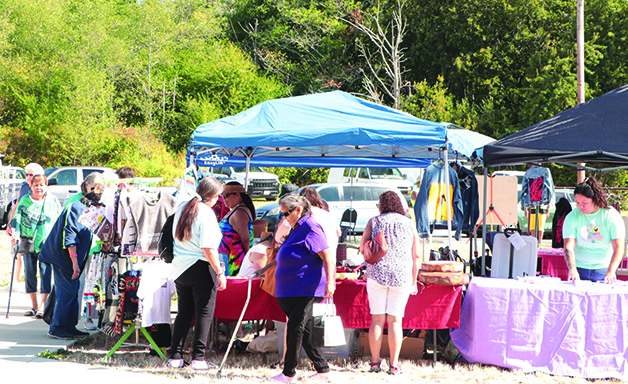
Some elders stayed at the Tulalip Resort and Casino. “There were 12 elders that made their way from Nespelem, Colville Tribe,” said Charles McKay. “It was a hot cruise over, but we made it. Having an enjoyable time, I spent the night at the casino, then came over here early in the morning. There are lots of good conversations to be had and good food.”
“You better believe it. I’m having a great time. I wouldn’t miss it for nothing,” Theresa Jones of Lummi said. “I have so much fun talking to my friends from all over. You just don’t get to see everyone like you used to.”
“We drove over early this morning,” said Marilyn Manzano of Yakima Nation. “This is an enjoyable event, and I just love the building. It’s my first time inside it, and it is so pretty that it almost makes me cry. Also, the people are nice here and made everything run smoothly.”
Building up the local recovery community: Family Wellness Court introduces Parent’s Talking Circle
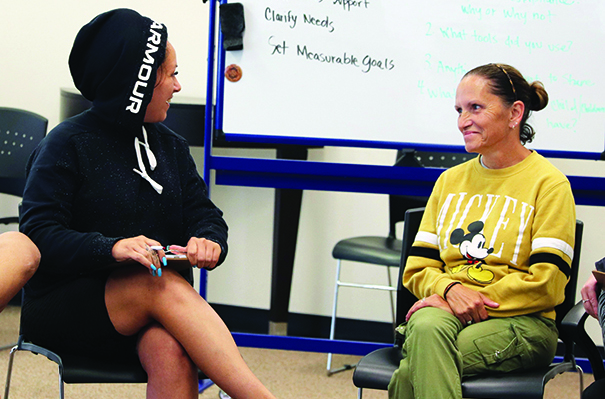
By Kalvin Valdillez, Tulalip News
On a scorching summer afternoon, four Tribal mothers found comfort inside the courtroom of the Tulalip Justice Center. In a relaxing environment, much different than the typical court setting, the ladies decompressed in the comfort of air conditioning as they joined together at the center of the courtroom and circled up along with the Tulalip Family Wellness Court team.
Established in 2020, the Family Wellness Court has proven to be an effective method in assisting their clients attain and maintain their sobriety. The program accelerates the reunification process between parents and Tulalip children by way of a detailed plan that incorporates their traditional way of life and culture.
This alternative path to the road of recovery has been a major success within the Tulalip community and has reunited numerous families over the past three years. The Family Wellness Court design was based on the success of Tulalip’s Healing to Wellness Court. However, the courthouse made many modifications when developing the Family Wellness Court model.
Although the Family Wellness Court’s game plan mirrors the Healing to Wellness Court model in many aspects, the court wants to stress that the two programs are completely separate from one another. Family Wellness is volunteer-based and works with individuals on their own accord, through either a referral or self-referrals, and is not mandated by the courts. Whereas the Healing to Wellness Court works on criminal cases, where their clients could potentially face jail time if they fall out of compliance. And since the Family Wellness Court is voluntary and does not work on criminal cases, there is no punitive element to the program and the clients do not face jail time if they fall off track.
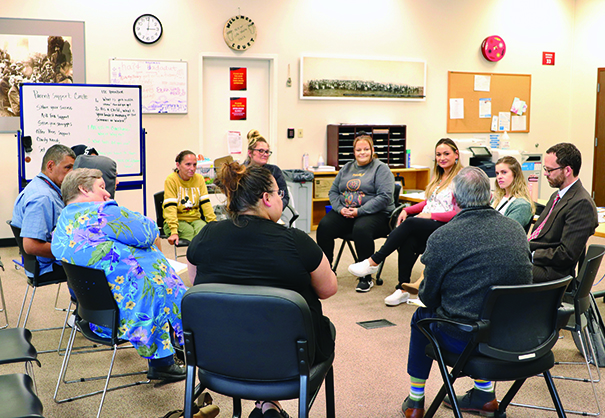
Overall, the program is built to support, encourage, and assist tribal parents and/or parents of tribal members as they work toward achieving a clean and healthy lifestyle. By following a personalized plan, put together by the individual and the Family Wellness Court team, the parents are actively fighting to regain visitation and custody rights of their kids and bring a close to their open beda?chelh cases.
The Family Wellness Court utilizes the wrap-around approach and brings together several different tribal departments to ensure each of their clients has access to the necessary resources throughout their duration in the program. The team approach plays a large role in the Family Wellness Court and in each participant’s recovery journey.
The team consists of multiple professionals including tribal courthouse judges, officials, attorneys, beda?chelh representatives, counselors and recovery specialists. The idea is that with everybody on the same page and meeting on a regular basis, the client is apt to stay in-compliance and make positive progress in maintaining their sobriety when they know exactly what their team expects from them.
The Tulalip Tribal Court believes that this collaboration between multiple departments, all with the same intent of helping people attain sobriety, is the key to success with Family Wellness Court clients. This helps them establish relationships with the judges and task force members and includes them in the entire process from the moment they accept help from the Family Wellness Court to the moment they are reunified with their children.
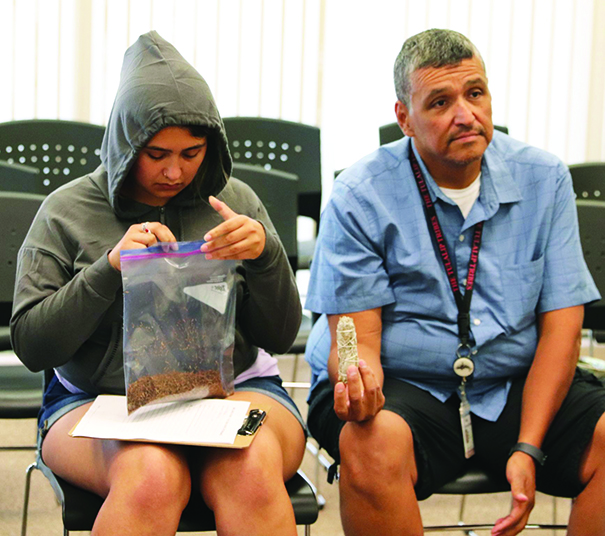
Many people are seeing great results with the Family Wellness Court model thanks to required ‘give back hours’. Not only does this afford tribal parents the opportunity to get reacclimated into the community, but also provides them with the chance to return to their ancestral teachings and traditional way of life through cultural engagement at local tribal events and ceremonies. Over the summer, the Family Wellness Court took this notion a step further by implementing the Parent Talking Circle into the program.
“We really wanted to incorporate the culture, especially in the Talking Circle,” explained Family Wellness Court Coordinator, Erika Moore. “We have a lot of parents who are non-tribal, and this is a good way to get our tribal members teaching the non-tribal members, so they in turn can teach their children more about their culture. It gives [tribal members] more confidence in getting back into their culture. And when we see them get back into their culture, they grow exponentially.”
Said Chemical Dependency Professional Arla Ditz, “The Talking Circle is more second nature to tribal members because it’s along the lines of the cultural teachings they were raised with. And it’s not just the culture, it’s that spirituality in general. One of the key things in successful recovery is the spiritual piece, no matter what you believe in or where you come from, it’s a really important part of recovery. And so, when we come into our circle, that really helps support that, and it brings the netting together to be more supportive for the people participating in the program. I think the Talking Circle helps people figure out their goals and achieve them much quicker, and maybe even better.”
Held at the beginning of each month, the Parent Talking Circle allows the clients to connect with each other and share their story, struggles, successes, and goals with the group. In this traditional and no pressure setting, the parents are more open to share and relate to one another’s journey, as well as express any hardships they might be encountering.
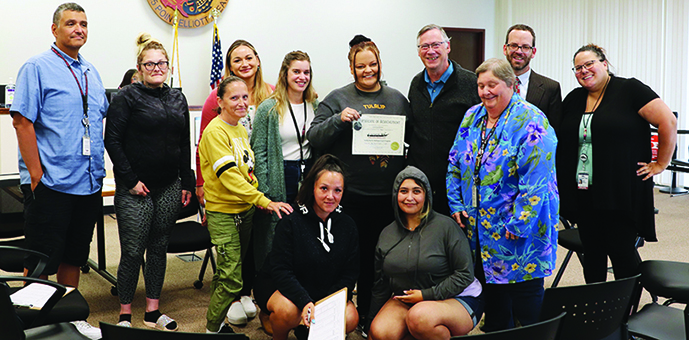
During the most recent Parent Talking Circle, the tears were rolling as the participants recounted their lifestyle prior to enrolling in the Family Wellness Court. To see how far each of them has come since the height of their addiction is heartwarming and inspiring. And hearing the moms talk about their daily interactions with their children was quite moving, considering all the adversities they had to overcome to share time and space with their kids once again.
“The Talking Circle has helped me stay accountable and encouraged me to keep going,” shared Tribal member Corrina Gobin. “It’s much more than just a circle. Today, I learned about the four sacred medicines, and it gave me the opportunity to learn something new with the whole group. Each person in the circle, you end up having a close and personal relationship with. We’re all available to help each other, whether it be rides to your kids, or back and forth to treatment, UAs, whatever it may be, they play a significant role in getting us through all the things we need to get through in order to get our kids back. They give me recognition when I’m doing things that are good, and they also call me out for not doing things that are good. I actually look forward to coming to court now because they give me that motivation.”
Tribal member Kerri Deen added, “I feel like it’s been helping me spiritually. Like the discussion today, it was about how to properly use sage and sweetgrass. The Talking Circle helps when we’re at a standstill and we’re struggling to meet our goals. No matter the situation, the team helps us get through those obstacles to get our lives back. It’s amazing and I love it because you don’t feel attacked. It’s more focused on helping each other get everything done so we can get our kids back.”
Though still in its infancy, the Parent’s Talking Circle shows nothing but promise in helping build up the local recovery community and reunify tribal children with their parents in a timely and responsible manner.
If you or a loved one are ready for a new approach to sobriety and reunification with your child, please contact the Family Wellness Court at (360) 716-4771.
Strong winds, and even stronger competition
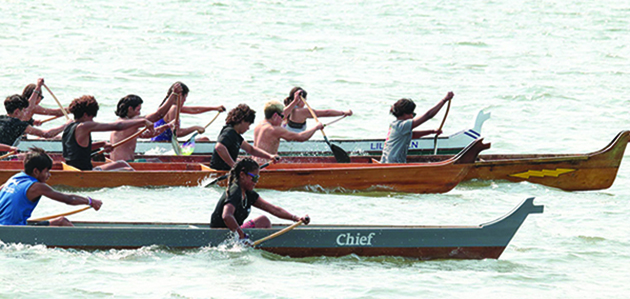
By Wade Sheldon, Tulalip News
The day was mighty gusty as canoe pullers from all over the Pacific Northwest and Canada battled waves in Tulalip Bay on August 18 during Tulalip’s Annual Canoe Races. The two-day event pitted the young and old in different canoe races. Although the waters were choppy, each competitor gave forth an outstanding performance.
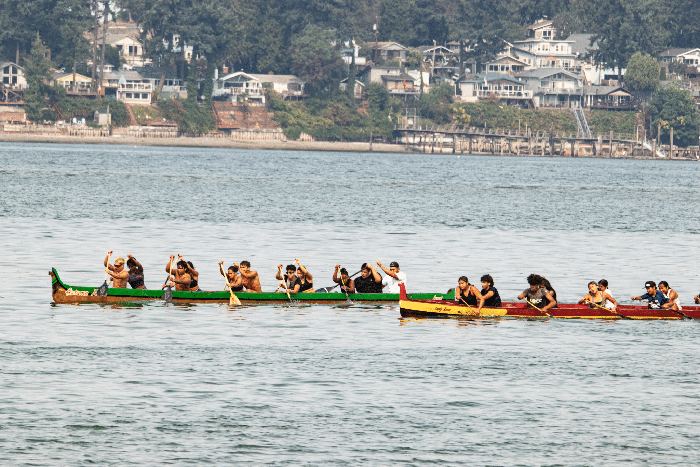
Starting at 9:30 am, Saturday’s competition was fierce. Not only were the competitors battling the strong winds and waves, but also each other to take home a trophy and some prize money.
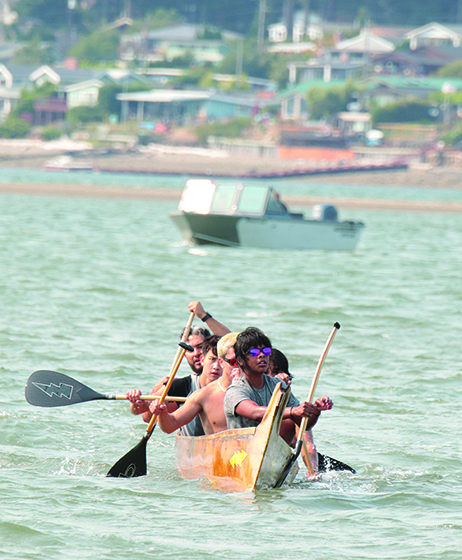
From single-person canoe races to 11-person teams, events for all levels of racers, male or female, gave many a chance at competing. There were races for kids nine and under to races for adults 19 and older, including a special race Saturday evening between co-ed partners of two. This consisted of one male and female partner who had to run with a paddle for about half a mile, then jump into their canoes and paddle for about a two-mile journey.
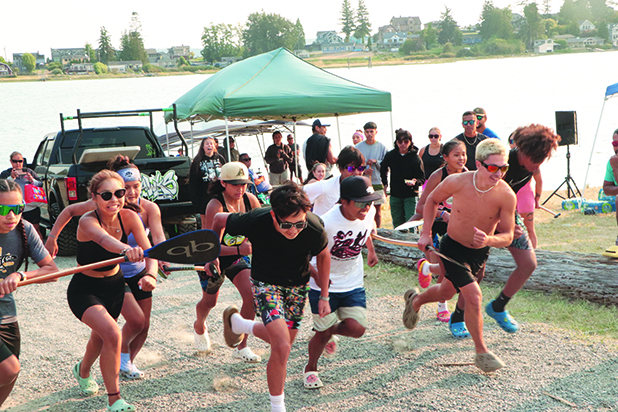
In the face of wind gusts reaching up to 15 mph, creating turbulent waters, dedicated pullers demonstrated unwavering determination, securing victories by multiple boat lengths. A few pullers would find that the seas were not playing around as some rolled over due to being off balance when the wind and the waves hit their canoe.
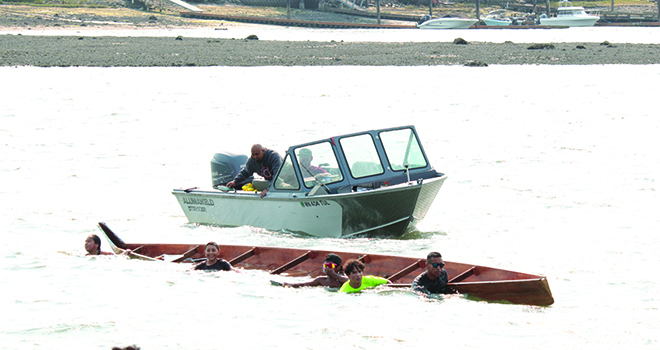
“You need to do a few things to prepare yourself to be out there on that rough water,” said Buddy Gray, from Cowichan, racing with Lummi. “You’re going to be tired; you’re going to get fatigued. You can’t quit. You paddle out, so you have to paddle back. Having that mental and physical strength is very important, as is healthy eating and keeping yourself hydrated so you don’t cramp up out there.”
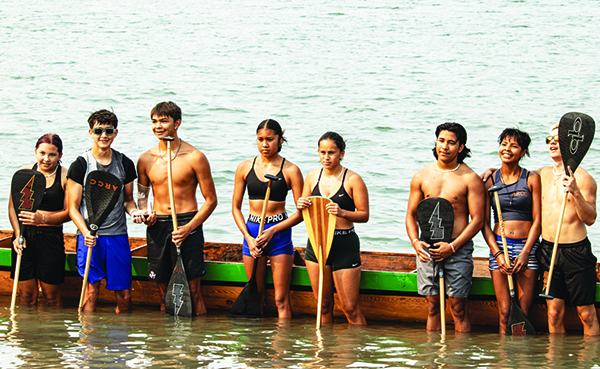
Buddy continued, “I’ve always had a different mindset on just paddling to win. I have kids now and have that mindset of being there, showing them a good way, and setting a better example for the next generation, as they are always watching. The more you train, the more you race, the better you get.”
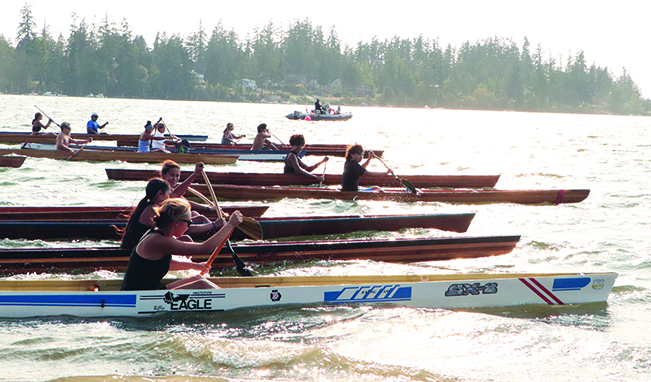
One of the teens who won a few different events in the 16 and under category, Elias Mamac of Lummi, said, “Eat lots of French toast, train, and get some rest to be able to race your best.” When asked why he loves canoe races, Elias said, “Makes me feel good.”

Although the waters were rough and the air was a little smoky, canoe pullers who braved the seas for the chance of victory took home the thrill of competition and great memories.
August 19, 2023 syəcəb
Please use the following link to download the August 19, 2023 issue of the syəcəb